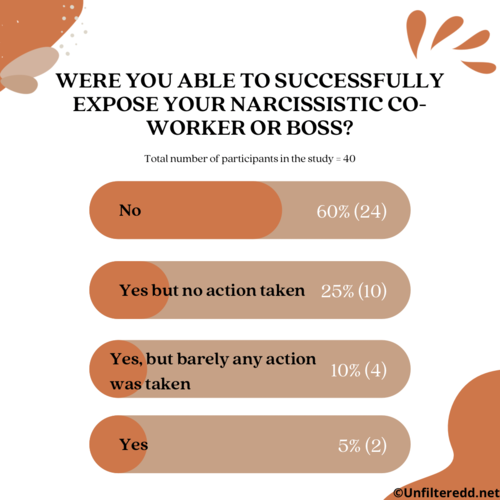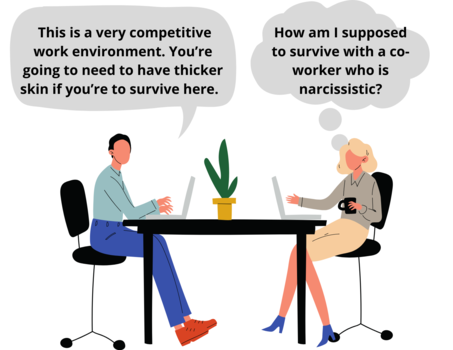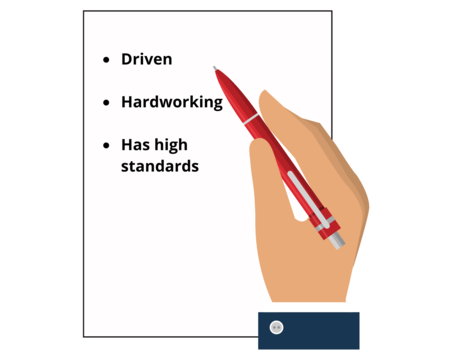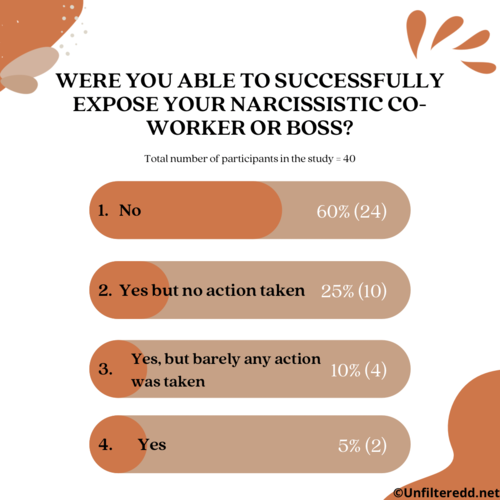One of the reasons narcissism is becoming more and more common to see, is because narcissistic behavior is often rewarded in our society today. We live in a society where we are encouraged to accumulate power, wealth, and dominance over others. Therefore, work environments have become a breeding ground for narcissistic behavior leaving many wondering how to expose a narcissist in the workplace.
In a study we conducted with 40 survivors of narcissistic work environments, we discovered that being able to successfully expose narcissistic behavior at your place of work is very unlikely, but not impossible.
We asked 40 victims of narcissistic work environments, “Were you able to successfully expose your narcissistic co-worker or boss?”

What makes narcissism in the workplace so difficult is that narcissists possess all of the qualities needed to excel in a competitive space like a workforce. They’re charming, intelligent, charismatic, desire power and control, and lack empathy.
Because of these personalities, they are often in leadership positions which makes the process of exposing them even harder, but again, not impossible. This article is going to cover the most important aspects of narcissism in the workplace so readers can understand why so many of our participants were unsuccessful.
Then this article will cover on the participants who were successful, and break down their advice on how to expose a narcissist in the workplace.
Healthy vs Pathological Narcissism In the Workplace
Before you try to expose a narcissist in a workplace, it’s important that you ensure you understand exactly what narcissism is. The Diagnostic and Statistical Manual of Mental Disorders, Fifth Edition (DSM-5) defines narcissistic personality disorder as a pervasive pattern of grandiosity, need for admiration, and lack of empathy.
Narcissism is most certainly a spectrum of abusive behavior. A majority of the information people have on narcissism is based on only one type of narcissist, a grandiose narcissist. These are the entitled, arrogant, charming, charismatic, and intelligent types of narcissist that you’re most likely to run into, especially in a work environment.

While there are different types of narcissists, their personality traits are relatively the same, with the one of the outliers being vulnerable narcissists who often come off as depressed and vulnerable.
We can pretend that we live in a world where competitive nature isn’t necessary to not only survive, but achieve our hopes and dreams, but that’s not reality.
Therefore it’s very important to understand the difference between healthy and pathological narcissism.
In her book Should I Stay Or Should I Go: Surviving A Relationship With A Narcissist Ramani Durvasula, Ph.D. defines healthy narcissism as the following:
“The ability to advocate for yourself, sometimes putting your needs ahead of others but remaining mindful of the impact of your choices on others.
The ability to exert an opinion respectfully and ask that others recognize it, maintaining self-confidence, and pursuing ambition but not deliberately at the cost of other people.”
Pathological narcissism is the polar opposite of that definition. Pathological narcissists lack empathy, are shockingly jealous, controlling, rageful, manipulative, and greedy human beings who have no concept of boundaries whatsoever.
So it’s important to understand the difference between someone who is competitive, hard-headed, and dominant and someone who is manipulative, mean-spirited, and evil.
In other words, just because you don’t see eye-to-eye with someone, doesn’t mean they are a narcissist.
Why Is It So Hard to Expose Narcissism In the Workplace?
The personality traits of a narcissist isn’t the only aspect of the narcissistic realm that often lands them in positions of power.
A narcissist’s emotional inadequacy causes them to overcompensate for their deficiencies with an insecure need for power and control.
It’s important to remember that this is a need. The emotional stability of a narcissist is dependent on the narcissist’s ability to control their environment.
Non-narcissistic people don’t ruminate about being able to control every waking moment of others’ lives, narcissists do. This correlates with the fact that a disproportionate number of people in leadership roles have narcissistic traits.
As you can imagine, it would be extremely difficult for a victim of narcissistic abuse to expose their boss, but it would also be very challenging for a victim of narcissistic abuse to be able to convince a narcissistic boss that the workplace is toxic.
What’s much more likely to happen is that the victim will get labeled as sensitive, lazy, and a liability.

Narcissist Enablers
We live in a society that is very cautious about the labels we put on others, which in some cases is justified, but in the narcissistic realm it’s damaging.
Narcissist enablers are people with a significant lack of knowledge about narcissism, which causes them to approach a narcissistic environment as they would non-narcissistic environments.
It’s very common for victims of narcissistic work environments to run into enablers while reporting abuse to HR, or other systems in place to handle abusive employees and/or supervisors.
When speaking to the 40 survivors of narcissistic work environments that we used for the study in this article, we found that each and every one of them were required to have an astronomical amount of documented evidence before HR, or other systems, were able to take action.
This is problematic because narcissists are so intelligent that their abuse goes often unnoticed to enablers, especially if it’s not directly impacting the enablers’ well-being.
So more often than not, the narcissist gets characterized by enablers as a driven, hardworking person who has high standards, so they are labeled as difficult, instead of abusive.

The Shame-Rage Spiral
Aside from being verbally abusive, narcissists foster an immense amount of fear within others due to their hypersensitivity to criticism and/or feedback.
A narcissist’s emotional inadequacy causes them to gravitate towards materialistic qualities rather than emotional stability when building their self-esteem.
For example, a narcissist is much more likely to determine someone’s worth based on their financial situation and public appearance, rather than the way they treat others.
This is a manifestation of their fear of being rejected, abandoned, and devalued by society. They spend their entire lives building a superficial reality in which they are perfect, so they can neglect their own emotional inadequacy.
As with any lie, it’s extremely difficult to uphold their falsified image for a lifetime, which causes their egos to be extremely fragile. So, when a narcissist experiences an ego injury, their inability to regulate their own emotions triggers their suppressed shame of inadequacy and they are thrown into a narcissistic rage.

As some of the most self-loathing individuals on the planet, narcissists violently despise any scenario where they are forced to look within themselves.
Because of the fragility of a narcissist’s ego, something as innocent as suggesting a policy change, a co-worker producing better work, or even constructive criticism has the potential to trigger a narcissist’s fear of not being good enough, causing their suppressed shame to be activated, throwing them into a rage.
This is called the shame rage spiral.
However, rage is rarely a justified response, especially when it’s in response to something as innocent as constructive criticism or feedback.
Therefore, when a narcissist rages, it contradicts their insecure need to be accepted by society, which again, triggers their shame. And because of their emotional inadequacy, they are unable to manage the emotional distress shame brings, so they rage to project their shame onto others, and the never ending cycle begins again.
The reason this response makes it so difficult to expose a narcissist in the workplace is because it terrifies people, especially those who don’t understand this aspect of narcissism.
People have bills to pay, a family to take care of, and a future to save for, so, they are much more likely to walk on eggshells around their narcissistic boss or co-worker rather than confront them about their behavior and potentially lose their job.

Flying Monkeys In the Workplace
There’s a fine line between flying monkeys and enablers, but what separates the two is their intent.
Enablers simply lack the knowledge required about narcissism to understand that they can’t approach a narcissist the way they do someone non-narcissistic to solve a problem.
Therefore, they give terrible advice to victims of narcissistic abuse, or like in a workplace, require that the victim present a large amount of evidence which is nearly impossible to get because of how intelligent narcissists are.
Flying monkeys are people narcissists manipulate into participating in a smear campaign of the victim. A smear campaign is a plan to destroy the reputation of someone or a group of people with lies and gossip.
Narcissists use flying monkeys when they’re on the verge of being exposed. For example, Brie Robertson, a survivor of narcissistic abuse that works with us, experienced flying monkeys from her ex husband.
What he did was he would tell Brie’s friends that she was bi-polar. So, when Brie went to confide in her friends about the abuse she was enduring, all he had to do was tell them that she was off her medication to make them ignore Brie’s claims.
As you can see, to enlist flying monkeys a narcissist will spread gossip and lies about the victim to ruin their reputation, and in the workplace this can happen as well.
In the workplace, flying monkeys could be recruited by the fear of being targeted by the narcissist’s rage and/or losing their job, or the traditional way, lies and gossip.
This makes exposing a narcissist in the workplace nearly impossible because the intent of flying monkeys, especially in a work environment, is to aid and abet narcissistic behavior by portraying the victim as the perpetrator and the narcissist as the victim.
Flying monkeys have been known to even go as far as pretending to be the victim’s friend to extract information out of them that could be useful to the narcissist.

So, imagine that Johnny is thinking about reporting his boss to HR because of his narcissistic behavior and he tells one of his co-workers, who’s terrified of their narcissistic boss, that he plans to report him to HR.
His co-worker then goes and tells the boss what’s going on, out of fear and hope to stay on his good side, so the boss goes to HR first and makes audacious claims of misconduct on Johnny’s end.
When Johnny gets around to speaking to HR, with no evidence, just his word, they automatically assume that he is the problem, not the boss, and he ends up getting pushed out of the company.
How to Expose a Narcissist In the Workplace: Study
To find out the best way to expose a narcissist in the workplace we conducted a study where we asked 40 survivors of narcissistic work environments, “Were you able to successfully expose your narcissistic co-worker or boss?”
Here’s what we found:

For this study, we classified categories 1, 2, and 3 as unsuccessful attempts to expose a narcissist in the workplace because no action was taken against the narcissist or the narcissist got labeled as “difficult” but remained employed.
This means that 95% of our participants were unable to successfully expose a narcissist at work.
However we did a follow up question with the 5% of the participants who exposed their abuser to find out how they managed to do it and we found out that they both had to secretly do surveillance on their abusers and keep an extremely meticulous documentation of the events that happened every single day.
Both of the participants also said that because of the flying monkeys and enablers, it took 4 to 6 months for their abuser to be fired after they presented the evidence to HR.
What Should You Take Away From This Article?
Victims of narcissistic work environments are fighting against the odds. Judging by our study, they should be prepared to document everything for at least a year, but even that isn’t a guarantee.
12 of the participants who were unsuccessful exposing their narcissistic boss or co-worker had collected evidence for months, some years, and it still wasn’t enough to yield a result.
Exposing a narcissist in the workplace is extremely difficult because we live in a society that encourages narcissistic behavior. If someone is successful enough, or brings the company enough money, their abusive behavior is overlooked.
About the Author

Hey, I’m Elijah.
I experienced narcissistic abuse for three years.
I create these articles to help you understand and validate your experiences.
Thank you for reading, and remember, healing is possible even when it feels impossible.
